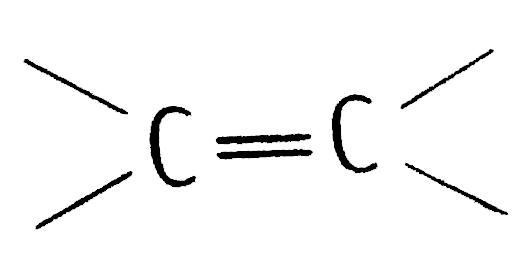The addition of HCl to an alkene proceeds in two steps. The first step is the attack of H+ ion to >C=C< portion which can be shown as



All of these are possible
The correct Answer is:B
To solve the problem regarding the addition of HCl to an alkene, we can break down the process into clear steps:
Step 1: Identify the Alkene
Let's denote the alkene as R-CH=CH2, where R represents any alkyl group.
Step 2: Protonation of the Alkene
In the first step of the reaction, the H⁺ ion from HCl attacks the alkene. The alkene has a double bond (C=C), which consists of a sigma bond and a pi bond. The pi bond is electron-rich and can act as a nucleophile.
Step 3: Formation of a Carbocation
When the H⁺ ion attacks one of the carbon atoms in the double bond, it results in the breaking of the pi bond. This leads to the formation of a carbocation on the other carbon atom. The reaction can be illustrated as follows:
1. The pi electrons from the C=C bond are used to bond with the H⁺ ion.
2. The carbon that receives the H⁺ becomes positively charged (carbocation).
3. The other carbon now has only a single bond and is left with a positive charge.
The reaction can be represented as:
R−CH=CH2+H+→R−CH+−CH3
Step 4: Resulting Intermediate
The intermediate formed is a carbocation (R-CH⁺-CH3), which is a key species in the addition reaction.
Step 5: Subsequent Step (Not Required by the Question)
Although not explicitly asked, the next step would involve the attack of the Cl⁻ ion on the carbocation to form the final product (alkyl chloride).
Summary of the Steps:
1. Identify the alkene structure.
2. Protonation of the alkene by H⁺.
3. Formation of a carbocation.
4. (Optional) Attack of Cl⁻ to form the final product.
Let's denote the alkene as R-CH=CH2, where R represents any alkyl group.
In the first step of the reaction, the H⁺ ion from HCl attacks the alkene. The alkene has a double bond (C=C), which consists of a sigma bond and a pi bond. The pi bond is electron-rich and can act as a nucleophile.
When the H⁺ ion attacks one of the carbon atoms in the double bond, it results in the breaking of the pi bond. This leads to the formation of a carbocation on the other carbon atom. The reaction can be illustrated as follows:
2. The carbon that receives the H⁺ becomes positively charged (carbocation).
3. The other carbon now has only a single bond and is left with a positive charge.
R−CH=CH2+H+→R−CH+−CH3
The intermediate formed is a carbocation (R-CH⁺-CH3), which is a key species in the addition reaction.
Although not explicitly asked, the next step would involve the attack of the Cl⁻ ion on the carbocation to form the final product (alkyl chloride).
1. Identify the alkene structure.
2. Protonation of the alkene by H⁺.
3. Formation of a carbocation.
4. (Optional) Attack of Cl⁻ to form the final product.
Topper's Solved these Questions
- ORGANIC CHEMISTRY-SOME BASIC PRINCIPLES TECHNIQUESBOOK - PRADEEPCHAPTER - ORGANIC CHEMISTRY-SOME BASIC PRINCIPLES TECHNIQUESEXERCISE - NCERT EXEMPLAR PROBLEMS WITH ANSWERS, HINTS AND SOLUTIONS (Multiple Choice Questions - II)
7 Videos
- ORGANIC CHEMISTRY-SOME BASIC PRINCIPLES TECHNIQUESBOOK - PRADEEPCHAPTER - ORGANIC CHEMISTRY-SOME BASIC PRINCIPLES TECHNIQUESEXERCISE - NCERT EXEMPLAR PROBLEMS WITH ANSWERS, HINTS AND SOLUTIONS (Short Answer Questions)
27 Videos
- ORGANIC CHEMISTRY-SOME BASIC PRINCIPLES TECHNIQUESBOOK - PRADEEPCHAPTER - ORGANIC CHEMISTRY-SOME BASIC PRINCIPLES TECHNIQUESEXERCISE - NCERT Questions and Exercises With Answers
40 Videos
- HYDROGEN BOOK - PRADEEPCHAPTER - HYDROGEN EXERCISE - COMPETITION FOCUS (Assertion-Reason Type Questions) Type 2
15 Videos
- P-BLOCK ELEMENTS (NITROGEN FAMILY)BOOK - PRADEEPCHAPTER - P-BLOCK ELEMENTS (NITROGEN FAMILY)EXERCISE - Competition focus jee(main and advanced)/ medical entrance special) (VIII. Assertion-Reason Type Questions)
10 Videos
Similar Questions
Knowledge Check
The addition of HCl to an alkene proceeds in two steps. The first step is the attack of H+ ion C=C portion which can be shown as
A B
B C
C DAll of these are possible
DAll of these are possibleThe additions of HCl to an alkene proceeds in two steps. The first step is the attack of H+ ion to
 portion which can be shown as A
portion which can be shown as A B
B C
C DAll of these are possible
DAll of these are possibleIn case of C4 pathway, the first step is :
ACO2 combines with RUDPBCO2 combines with PGACCO2 combines with PEPDCO2 combines with RMP
Electrophilic addition reactions proceed in two steps. The first step involves the addition of an electrophile. Name the type of intermediate formed in the first step of the following addition reaction.
H3C−HC=CH2+H+→?
View SolutionElectrophilic additions reactions proceed in two steps. The first step involves the additions of an electrophile. Name the type of intermediate formed in the first step of the following addition reaction H3C−HC=CH2+H+→?
View SolutionElectrophilic additions reactions proceed in two steps. The first step involves the additions of an electrophile. Name the type of intermediate formed in the first step of the following addition reaction H3C−HC=CH2+H+→?
View SolutionIn aqueous solution H,2SO4, ionise in two steps. In first steps it produces ?
View SolutionBoth CH4 and C2H6 can be prepared in one step by the reaction of
View Solution
